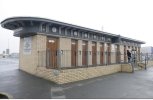Speaking of toilets, and not entirely off topic – I remember some years ago as a youth needing to pay a visit to the Gents at the eastern end of the Manchester-bound platforms at Bolton Trinity Street.
Standing against the porcelain, I was impressed by the lavish lavatorial provisions around me, presumably built by the L&YR. The cavernous, empty, echoing room was in finest Victorian style – fully tiled, with lots of brass and copper fittings and occasional hissing, trickling cisterns. There was modest provision of cubicles for those with more serious business to conduct, but the other three long walls were filled entirely from end to end with a huge number of urinals.
I remember thinking “how many people catching a train to Manchester would need to do a wee at the same time?” Then the penny dropped

– obviously this capacity was needed when returning excursions from Blackpool or Southport pulled in of an evening, with some punters having travelled in non-corridor rolling stock after consumed ample refreshments at the seaside (and maybe hadn't had time to use those facilities at Blackpool Central before departure). Not sure if the Ladies were equally lavish, or how generous the gents are at Bolton today.
In similar vein, I once read an account of life as a goods shunter in the Bury area. The youthful protagonist was on his first evening shift in the yard when one of the old hands recounted lesson no. 1 – “if a passenger train pulls up unexpectedly at signals in the dark, stand well back”. Chances are it was a returning excursion and a good fraction of compartment doors would be flung open and a number of warm, acrid streams would emanate from the train!


